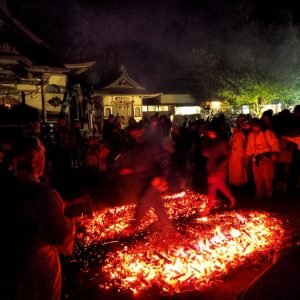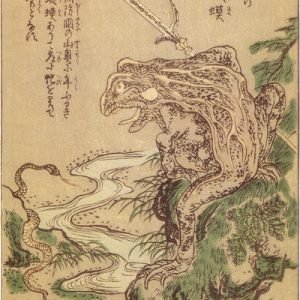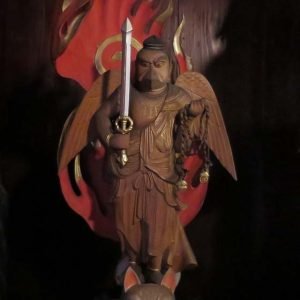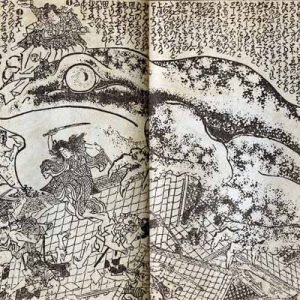Akihasan (Akiha Mountain) is said to have first been opened up and explored by the Buddhist monk Gyoki in the second year of the Yōrō era (718 CE), during the reign of empress Genshō-tennō (元正天皇).
The site of the first temple was called Daitozan Reiun-In (大登山霊雲院) and the main Kannon statue of the temple was said to have been hand made by Gyoki himself. It was a pure Buddhist temple with no other religious elements being practiced at the site at the time.
During the years of 810 to 823 CE, at the imperial request of Emperor Saga, a complete Buddhist compound was laid out and completed. The now expanded site was renamed Akihasan Shūyōji or “Autumn Leaf Mountain’s Autumn Leaf Temple” (秋葉山秋葉寺).
Akihasan Sanshakubo (三尺坊) is a famous tengu who is said to have been the leader of the Tōtōmi tengu group, but his true historical identity was a high level shugenja born and raised in Togakushi village. According to Shūyōji tradition, he went to the Zaogongen Temple in Echizen to train in shugendō. At 26 years old he became a Daiajyari (大阿闍梨) or the head of religious teachings at the temple and took on the name of Sanshakubo (三尺坊). At 27 years of age he was trained in the secret method known as Fudo Sanmi (不動三昧) and then transformed himself into Garuda, a divine creature with a human torso and birdlike head found in Japanese Buddhist epics.
Tradition says that after becoming Garuda he rode on the back of a white fox around the nations and finally landed at Mt. Akiha in 809 CE. When he arrived there for the first time a large toad appeared with the characters for “Akiha” (秋葉) mysteriously floating on its back. From this apparition he named the mountain “Akiha” or “Autumn Leaf”. It is important to point out here that Togakushi has a tradition of Gamagaeru Toad magic including the use of its oils as a hallucinogenic. You can find many stories about the warrior magician from Togakushi named Jiraiya who uses Gamagaeru Toad magic.
A preserved document titled “A List of Famous Shinano Buddhist Monks” 『信濃名僧略伝集』 states that Sanshakubo trained at Mt. Togakushi during the Eikan Era (983-984 CE). Looking at the history of Japan, we can see an increase of shugenja activities began after the middle of the Heian Period (794-1185 CE), and the Tengu traditions began to spread after the Kamakura period (1185-1333 CE). I can easily imagine the history of Akihasan as follows; sometime, during the middle of the Heian Period, a Shugenja named Sanshakubo came from Togakushi to Akihasan and developed the temple. Later, in the Kamakura Period, his achievements were celebrated, and he became deified as a tengu.
One last thing about Sanshakubo, legends say that he, among other Tengu, taught Minamoto Yoshitsune swordsmanship and military strategy. According to Takamatsu Sensei these Tengu were teaching Yoshitsune Gyokko Ryu Happobikenjutsu. I will cover more details about this in my upcoming book “The Hidden Lineage – Origins of the Imperial Tigers”.
During the Warring States Period (1467-1615 CE), the Amano clan that ruled the area were caught up in the wars between the Tokugawa and the Takeda clans. As a result, the Akihasan area and the temple were devastated. The person who revived the area was Morin Kohata (茂林光幡), a trusted Onmitsu secret agent (隠密) of Tokugawa’s. He was eventually made the head administrator of Shūyōji Temple. Kohata changed the practice of the temple to the Soto sect of Buddhism in order to rebuild. But the original shugendō system remained strong and the temple became a mix of Buddhist and Shinto practices. Eventually, Akihasan spread its deity of fire faith in the Kanto, Tokai and Hokuriku regions and its pilgrimage route came to be known as the “Akiba Kaido” or the Akiba Roadway.
Researched and translated by:
Sean Askew
Bujinkan Kokusai Renkoumyo
March 11th, 2020

















